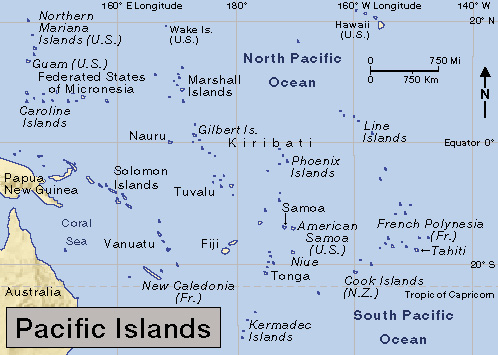Caroline Islands (pop. 130,000) are a group of more than 930 islands in the Pacific Ocean. They lie just north of the equator, between the Marshall Islands and the Philippines. The island group extends more than 2,000 miles (3,200 kilometers), but the combined land area of the Carolines is only 448 square miles (1,161 square kilometers). The Carolines are spread over two countries—the Federated States of Micronesia (FSM) and the Republic of Palau. The FSM consists of four main island groups—the states of Chuuk (formerly Truk), Kosrae, Pohnpei, and Yap. Palau consists of one main group of islands and several distant atolls. An atoll is a coral reef surrounding a large lagoon. The Carolines are part of an island group called Micronesia, which means small islands.

The Yap and Palau islands were among the first island groups to be settled in Micronesia. Archaeologists believe that people from Asia moved to those islands thousands of years ago. Kosrae, Pohnpei, and the Chuuk Islands were later settled by people from Asia.
In the 1500’s, Spanish explorers became the first Europeans to reach the Caroline Islands. Spain formally claimed the islands in 1885 and sold them to Germany in 1899. Japan captured the Caroline Islands during World War I (1914-1918). After the war ended, the League of Nations gave them to Japan as mandates—that is, colonies or territories placed under Japan’s administration. Japan fortified some of the islands. During World War II (1939-1945), United States forces captured some of the islands, including Peleliu.
In 1947, the United Nations made the United States trustee of the Carolines as part of the Trust Territory of the Pacific Islands, which also included the Marshall Islands and the Northern Mariana Islands. In 1978, the United States agreed to give the Carolines self-government. The agreement divided the islands into two groups—the Palau Islands and the Federated States of Micronesia. In 1979, the Federated States adopted their own constitution. In 1986, they gained independence in free association with the United States. In 1994, the Palau Islands, renamed Palau, also became an independent nation in free association with the United States.
Under the Compact of Free Association, the people of Palau and the FSM control their internal and foreign affairs, but the United States must defend the islands in emergencies. The United States can veto foreign relations decisions that could jeopardize its ability to defend the area.
